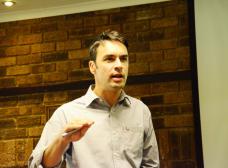Community digs in against proposed mine
Jasper Raats (jasper@noordnuus.co.za)
One thing became very clear at the series of public participation and focus group meetings where Sylvania Platinum’s proposed Volspruit mine in the Nyl floodplain was discussed last week - the communities of Mokopane, Mahwelereng and Mookgophong do not want the mine.
The proposed platinum and base
metals mine will be situated about
halfway between Mokopane and Mookgophong. It will have a19-year lifespan and will include a smelter and metal refinery. The mine looks to employ 450 people who will have to find their own
accommodation.
Environmental assessment practitioner appointed by Sylvania, Theo Fischer from E-Science & Associates, told attendees to a public participation meeting in Mokopane last Thursday that the proposed mine situated next to the Nyl river will not
significantly impact on the wetland system due to the presence of a clay layer that separates the ground and surface water. “After comprehensive process of assessment we have concluded that, provided mine sticks to strict controls, it will not have a significant impact.”
But the community feels this conclusion is based on assumptions the environmental assessment team arrived at through modelling flood event scenarios and not through actual measuring. No flood occurred during the assessment period.
“If they expect us as a community to trust them, they would not place the whole area, the livelihood of people, the water and the environment at risk at all cost. They would allow [the appointed hydrological expert] Dr. Giep du Toit, to see a flood event or possibly more than one flood event. We simply cannot trust them,” Emile Honiball, legal representative of the Nyl Action Group said.
“The reason they don’t want to
witness a flood event is that they are at jeopardy to lose their mineral rights by allowing the expert the time to do his job properly,” he continued.
Fischer conceded that actual
measuring of a flood event would have been ideal, but said his assessment team is satisfied that the proposed mine would not cause a disturbance to the flood dynamics of the Nyl to the extent that it causes irreparable damage.
But the fight is about more than just the flood dynamics of a sensitive wetland system. It is about drinking and irrigation water for a vast area. Andy Goetsch of the Mokopane Business Chamber expressed his concern for the impact the mine would have on the downstream communities living to the north-west of Mokopane and which rely on shallow boreholes pumped by hand for their
water needs.
Fischer explained that the majority of abstraction currently taking place in the Nyl system is for crop agriculture.
“The wetland system has already been impacted by these activities.
Mining, with a minimum abstraction of 0.5mega cubic metre per year, will
increase abstraction by 11% and there will be a further 2,5% decrease in run-off. Less water will be available.”
But he alleged that the water use registered with the department of water affairs and the actual hectares under irrigation does not ad up and stated that the mine will apply to legally extract water.
“It will, if approved, lead to further stress to the system. This catchment needs to be more holistically managed. Demands made of the mine to legally abstract and to minimise impact should be applied to all users,” he said adding that the farmers use about double the water they have registered with DWAF.
Piet-Louis Grundling of the Limpopo Wetland Forum took him to task for this statement saying he questions his
integrity as an independent consultant. He also said the research team is focussing on very short term climatic events. “In all the data shown here we stop very short when going back into history. What happened in the previous ten to 11-year wet cycle?”
Grundling said he doubts the assumption that surface- and ground water is divorced if it is only based on such a short research period.
Du Toit agreed saying 50 years ago the Nyl might have been a gaining river ie. not two separate water bodies. “We also suspect that the water is filled back by flooding events and would have liked to have seen a flood event,” he said. “Our models are a simple indication of nature we can expect variation.”
Du Toit insisted that all boreholes in the area must be monitored on a regular basis and any influence of the mine on a borehole must be identified and must be corrected.
Based on this the Mokopane Business Chamber wanted to know what guarantees Sylvania is prepared to give that it would stop if a decline in water becomes evident.
Fischer explained that the assessment team can recommend that the mine should cut back operations and reduce consumption, should it have a larger impact on available water than envisaged, but he pointed out that it would then have to be proven that the water reporting to downstream users is not reduced by other users such as alien vegetation, municipalities and irrigation.
Shortly before the meeting adjourned, Honiball pointed out that the Nyl system is declared a subterranean water control area under old Water Act and that according to law, mining in such an area is prohibited. Fisher promised to get more clarity on this issue, but at the time of going to print, Honiball said he hasn’t had any feedback.













0 Comments